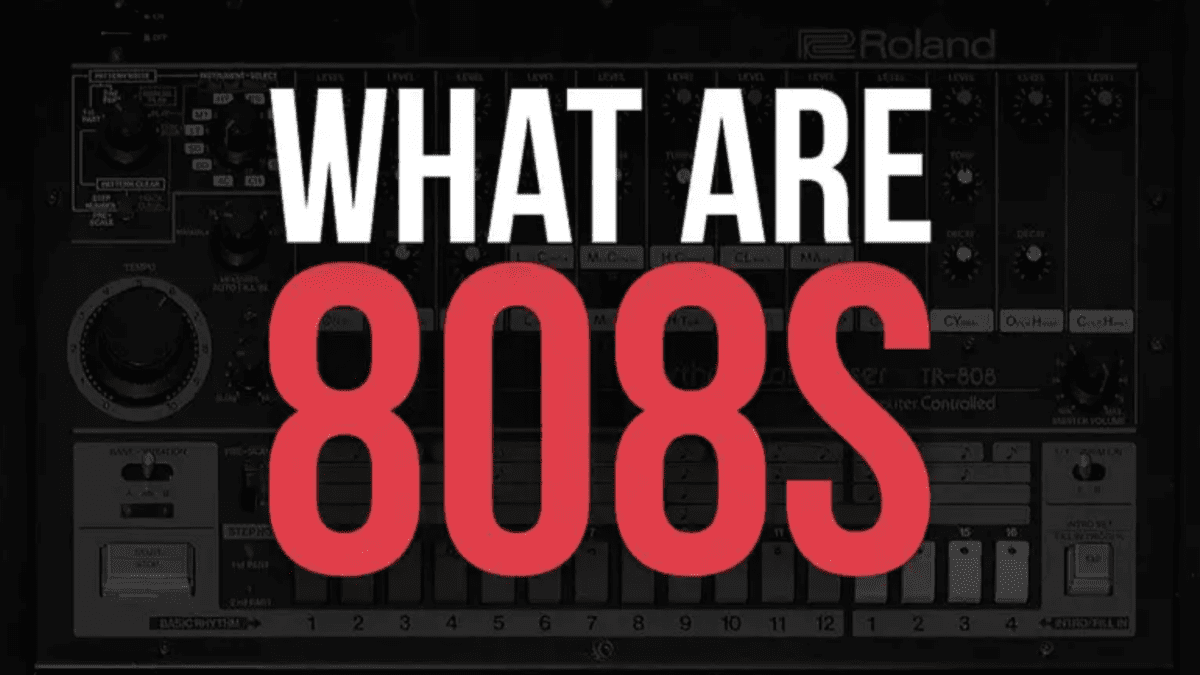Have you ever wondered, what is a digital piano? Or, what is a good digital piano for beginners? Well, you have come to the right place!
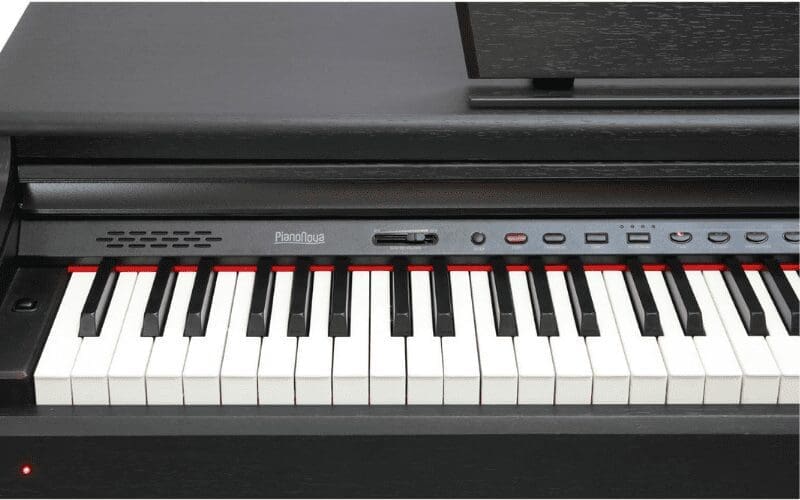
A digital piano is a type of keyboard that includes onboard, pre-recorded instrument samples. Which can be played expressively using the keys.
The keyboard is a category encompassing anything with keys, including digital pianos, and analog synths. In addition to any MIDI-only controllers with keys.
The sounds on most beginner digital pianos are static. Meaning you cannot change the characteristics of your sounds besides adding reverb or chorus effects.
Most digital pianos are MIDI capable via USB, so you can record MIDI into your DAW like other MIDI keyboards.
This article is the ultimate guide to the best digital piano for beginners.
If you’re unsure of how to start in the world of digital pianos, then stay tuned for some super helpful tips and tricks!
What Is A Digital Piano vs Keyboard

One difference to note between MIDI-capable digital pianos and MIDI keyboard controllers is that, unlike digital pianos, MIDI keyboard controllers do not have built-in sounds.
They are meant for playing and controlling analog synths, software synths, effects, and other programmable features through your DAW.
Another distinction we should make is between digital pianos and analog synthesizers. Not all of which have keyboards.
A synthesizer allows you to manipulate a circuit to create and mold electronic sounds. While a digital piano comes with a variety of preset sampled instruments.
If you would like to learn more about the difference between digital pianos and keyboards, check out our article on Digital Piano vs Acoustic Piano.
For the purposes of guiding beginners on their journey to finding the right digital piano, I’ve kept all the options to full-size.
Read on to learn more about what would be the best fit for you!
Why Digital Pianos?
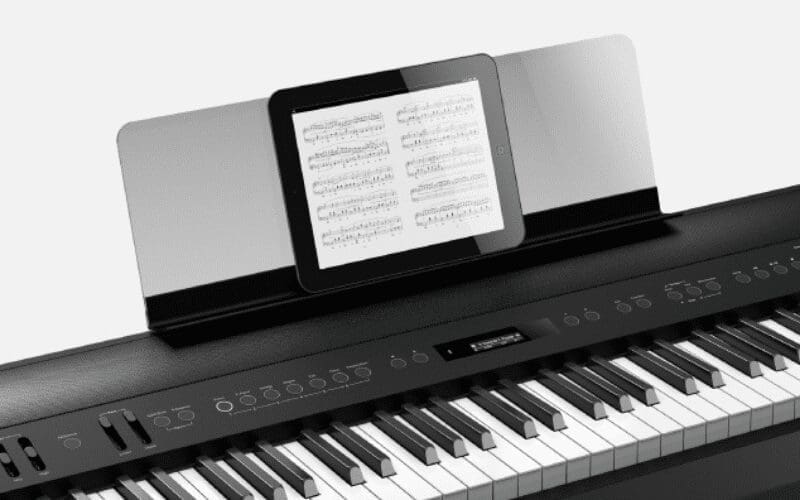
Digital pianos allow us to play sounds and instruments that might otherwise be inaccessible due to noise or spatial constraints.
At their most simple, these electronic keyboards emulate a few orchestral sounds. As you get more complex, you’ll find more sounds and parameters to adjust particular sound characteristics.
As well as built-in effects, and weighted keys for more authentic playability. And many more features that go beyond the scope of this article.
These additional features add to the authentic sound and feel that an acoustic instrument would offer. And some go beyond. More advanced digital pianos and synthesizers often contain features that allow the user to record or sequence performances for automatic playback.
For this article, I’ll be covering digital pianos for beginners. These instruments are the simplest, most cost-effective, and most portable options for getting started.
While the digital piano models I’ve chosen may appear limited in some regards, these limitations keep costs down and help beginners stay focused on the fundamentals of learning to play.
Put simply, the number of sounds doesn’t matter in some cases. The quality of each sound is not compromised by the number of sounds included on the device.
Many digital piano manufacturers have high-end product lines. Meaning the quality of their sound engines will be relatively consistent across their products.
Some of Roland’s piano sounds, for instance, are used across its low-end and high-end products.
The biggest differences between low-end and high-end digital pianos would lie in the materials of the keyboard case and the weight of the piano keys.
As well as in the control over each individual sound’s tone. And other small features that more advanced players and synthesists use.
So, if you’re a beginner looking for an affordable instrument that’s compact and portable with some cool orchestral sounds, read on for some of the best options to get started!
How Do I Choose the Right Digital Piano for Me?

Fifty years after the first digital pianos were rolled out, there are now dozens of digital piano models to choose from.
So, what is a good digital piano for beginners?
To simplify your search, I’ve picked my top six current digital pianos for beginners with a couple of honorable mentions.
I’ve based my selections on price, available sounds, playability, portability, and other features that set them apart from the rest.
Whatever your criteria, this is a great starting point in your search for a digital piano.
Top 6 Digital Pianos for Beginners
Roland Go Piano
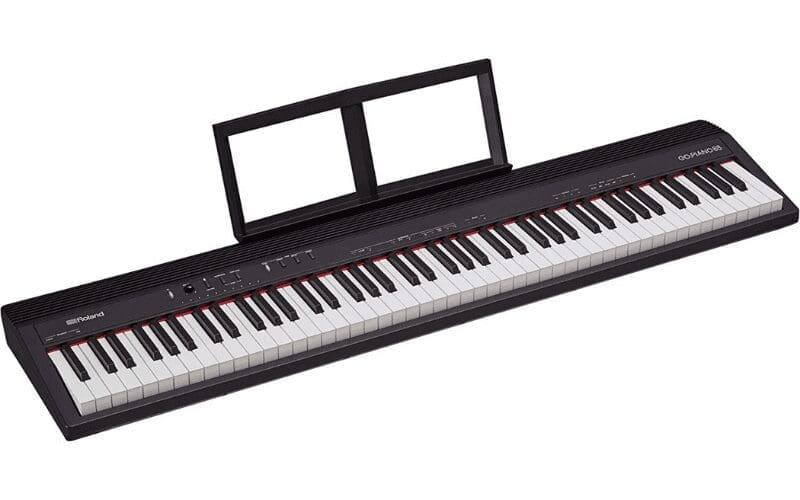
The Go Piano is Roland’s entry-level digital piano. It is perfect for beginners who want a full-size keyboard without breaking the bank.
This keyboard’s 88 keys are not weighted, making it very light. At 7 kg (~15 lbs) this digital piano is highly portable and can be battery-powered using D alkaline batteries.
This piano also includes a built-in Bluetooth speaker. Which you can use to connect wirelessly to any Bluetooth-enabled smartphone or tablet and play music or practice lessons.
Roland has an application called Piano Partner 2 that can sync with the keyboard. This app offers online lessons, recording, and even remote control of the keyboard.
The Go Piano is notable for its portability and built-in speaker, but it has fewer sound choices than some of the other models described in this article.
You can choose from four sounds: Piano, Electric Piano, Organ, and Strings. While the number of sounds is limited, they fulfill the basics that any beginner would need to start playing.
Also notable is the adjustable reverb effect, which can give your performance a bigger sound quality.
One of the advantages of buying anything made by Roland is that the company has a deep catalog of products across the price spectrum.
And while some products may differ from others, the core sound has been trusted for decades.
So you shouldn’t be scared by the small number of included sounds. The quality of the sounds are top-notch, and will satisfy a beginner’s needs for a long time.
Now, the Go Piano is an affordable entry point for beginners and is my recommendation.
Williams Allegro III

The Williams Allegro III is a full-size, 88-key digital piano with five main sounds and one variation per sound, making ten total sounds.
It also includes onboard reverb and chorus, but you can use the Williams Piano app to make additional adjustments to the digital piano’s tone and effects.
Another useful feature is the ability to split the keyboard into two different sounds. So, if you want to simultaneously play a bass sound using your left hand and a piano sound with your right, you can enable that on the Allegro III.
Using the Williams Piano app to adjust tone is a great feature, but there’s more. When you purchase this digital piano, you get access to a three-month trial of Skoove. An app that provides over 400 lessons to improve music reading and playing skills.
With the built-in Bluetooth speaker, you can wirelessly connect your device and play along with your lessons. Or any other music you like to practice.
The included Skoove trial is a huge win for this digital piano. But I have to say my favorite things about the Williams Allegro III are the weighted keys and the electric piano sound.
At its current price, it’s hard to beat these features.
Alesis Recital
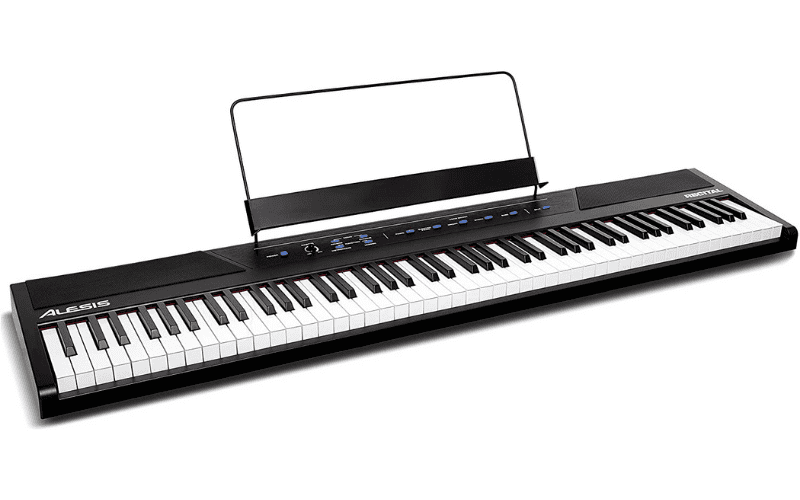
The Alesis Recital is the most affordable digital piano on this list.
With 88 keys and a full-size, semi-weighted keyboard, this keyboard competes with the other options through its simplicity.
This piano has six total sounds and two onboard effects. But like the Williams Allegro III, you can split the keyboard, or even layer two sounds on top of each other.
While this digital piano is fairly simple, its learning tools are superior to many of the other options on this list. Notably, you can split the keyboard into identical sections of equal pitch.
This allows two people to sit side by side and play the same notes. In a teaching application, the teacher can play a piece and have the student repeat the exact pitch. Without having to trade places and play the same section of the keyboard.
In addition to having this splitting feature, the Alesis Recital comes with not one, but two options for trying out free lessons. This makes it one of the best options for beginners who do not yet have a personal teacher.
Like the Allegro III, the Alesis Recital comes with a free three-month trial of Skoove. But it also comes with a two-month trial of Take Lessons. Which is the largest lesson company in America, and connects students to real teachers.
In terms of affordability, simplicity, and potential for learning, the Alesis Recital is the best option on this list.
KORG B2
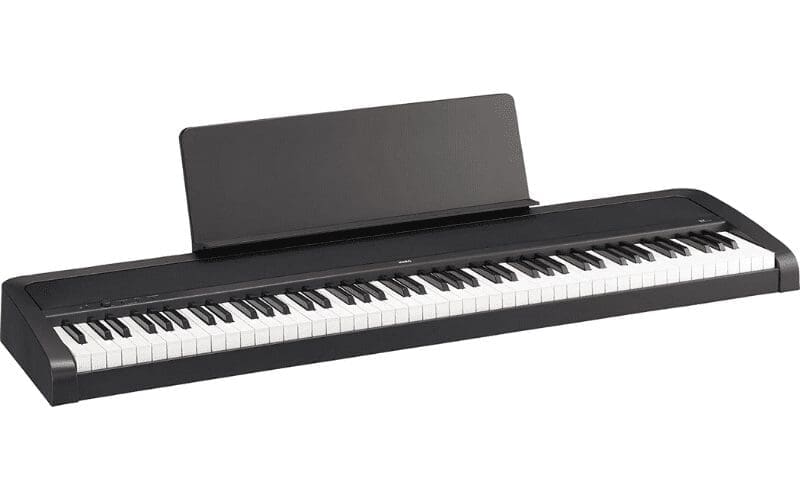
A little pricier than the Alesis Recital, the KORG B2 features natural weighted hammer-action keys. Which gives the player a more authentic piano feel.
Each of its five core sounds has tonal variations, making a total of twelve sounds. The onboard reverb and chorus effects also help make the sounds bigger and more expressive when desired.
One of the best features of this digital piano is its physical build. The keyboard unit is sleek, and simple, and doesn’t distract the player with buttons, screens, or sliders.
It is one of the best options for simply playing piano and not worrying about sound options. That being said, connecting your phone or another device via USB opens up more possibilities for learning and adjusting the sound.
Unfortunately, this digital piano is not equipped with a Bluetooth speaker like many of the other options discussed here. Instead, you’ll need to connect an 1/8th inch audio cable to play music from your phone.
In order to adjust parameters on the keyboard through KORG’s app, you can use a USB connection to your device. Full disclosure, you may need to use a dongle or other adapter to connect your device.
While it is a little frustrating to see a higher price for something that does not include the same hi-tech features as more affordable options. I appreciate KORG’s efforts in making the instrument as realistic to play as possible.
KORG also wins out by including a software bundle that allows users to record and arrange their music and take it with them on the go.
KORG Gadget 2 LE is a nice, simple digital audio workstation (DAW) that makes recording possible. And KORG Module gives users the option to explore different sounds using an iOS device.
On top of the attractive software bundle, KORG has joined Alesis and Williams in partnering with Skoove to offer a free three-month trial with the purchase of this digital piano.
Yamaha P45

The Yamaha P45 is my favorite digital piano on this list.
Although pricier than the other options, I find the sounds and playability to be the best. And personally those are my top criteria.
The P45 features five sounds with one variation on three of the sounds. That makes for a total of ten sounds. But I don’t feel limited given how expressive this piano is.
With graded hammer action, the keys have an authentic piano feel that is heavier on the bottom, lighter on top, and very responsive to touch just like with real pianos.
As with the KORG B2, I love the simplicity of the physical unit. One minor detail that I don’t like is the way you select sounds.
Rather than choosing a button on the faceplate of the unit, you have to click a button. And then click a corresponding key on the piano. I imagine this was to reduce the number of buttons on the faceplate, but it feels strange.
That being said, the sounds themselves are top-notch. Yamaha is a powerhouse in the field of pianos, acoustic and digital. So you can trust the integrity of their products.
With decades of knowledge and experience across all price ranges, even the most beginner digital piano in Yamaha’s catalog has that professional quality.
Similar to some other keyboards on the list, the P45 includes USB for recording and sequencing applications. And allows you to layer two sounds on top of each other to create interesting sound combinations.
And just like the Alesis Recital, you can split the keyboard into two identical sections for teaching applications.
So if you’re looking for affordability and you’re choosing between the Yamaha P45 and the Alesis Recital, I’d go with the Alesis Recital.
If you’re looking for authenticity to a real acoustic piano, I’d go with the P45.
Final Thoughts

When you’re looking for a digital piano as a beginner, you likely need something compact, portable, affordable, and quiet (headphone-capable).
All of the digital pianos listed in this article fulfill those criteria, with one or two less-affordable options. Simplicity is the best way to learn something brand-new.
If you’re an absolute beginner, you’ll want to go for the simplest digital piano option with the best educational add-ons. That would be the Alesis Recital or the Williams Allegro III.
If you’re more of an intermediate to advanced player, you may still want a portable digital piano option to bring to the studio or play an outdoor gig. In that case, you’d want a digital piano that is portable. And most authentically represents an acoustic piano in both its sounds and feeling when you play.
For those purposes, you may wish to look into the Yamaha P45 or the KORG B2.
Regardless of your current skill level, there is a digital piano out there for you. Refer to this guide whenever you decide to go out and purchase one!










